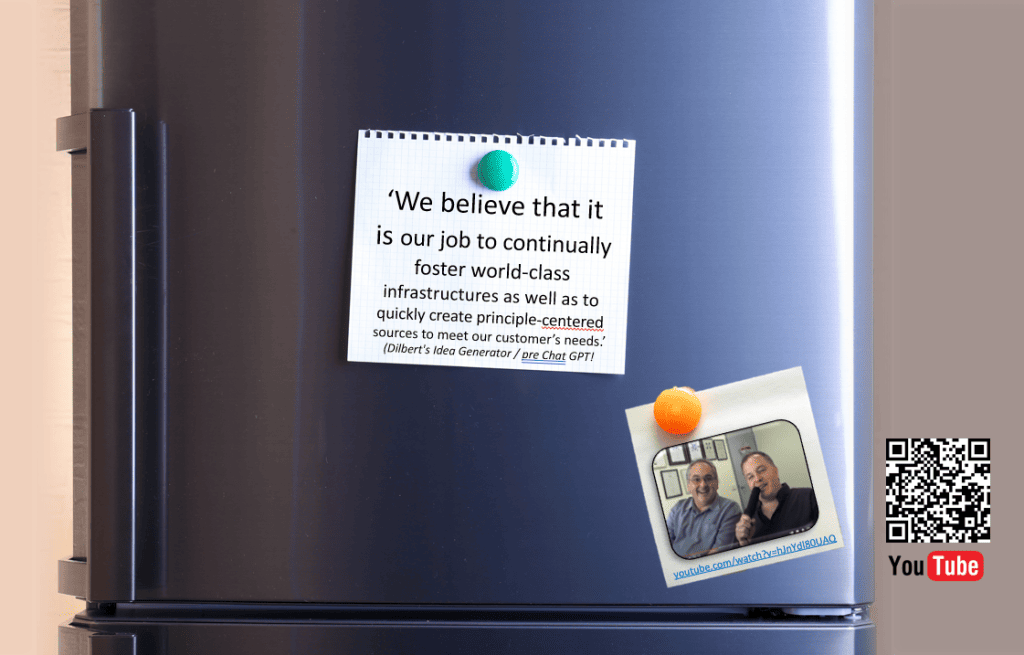Who is in control of the organizational narrative: vision, mission, values?
In the bustling world of business–where market turbulence is a constant threat–tangible spreadsheets, bottom lines, and quarterly reports that signal financial survival or success can reign supreme.
In this environment, it’s easy to forget about or sideline anything that doesn’t appear to relate directly to the bottom line. The soft ‘values-based’ stuff can seem superfluous.
Enter the established narrative shaping trio: vision, mission, and values. As the focus on the bottom line becomes sharper, carefully crafted mission and vision statements can feel more like fluffy declarations consisting of corporate jargon that should remain on the periphery. They will often adorn office walls and become established artefacts in company documentation and websites, only to gather dust after the executive retreat is long over.
But are these ‘corporate speak’ statements truly inconsequential?
What happens in the absence of a clear organizational narrative?
When we conduct workshops to examine and craft the organization narrative, we are often met with cynicism. Employees squirm, questioning the relevance of these seemingly abstract concepts. After all, they ask, does this really impact the bottom line?
I remember a particular client workshop for a start-up in the IT industry when a group confidently declared, “We don’t need a vision or mission statement. They’re out of date!” I had a sense that there was a deeper issue at play.
In a coffee break, I asked a few people why they felt this way, and they explained that the CEO founder had an obvious goal that he didn’t share openly, but everyone knew about. They knew his goal was to sell the company and sail into retirement. Case closed, right? Not quite.
Beneath the surface, in the absence of a conscious and shared values-based aspiration, a silent destructive narrative was emerging.
Without formalized VMVs (vision, mission, values) that the staff could contribute to and feel proud of, they had developed their own unofficial goal: Make as much money as you can while you can then get out fast. What was especially sad was that this organization was actually doing something to help society, but the CEO and employees seemed to have completely lost sight of that positive purpose.
The CEO’s desire to cash out influenced everyone else’s unspoken ethos. The staff’s behavior changed over time, and soon, they were operating as hired guns—mercenaries in pursuit of a paycheck.
Organisations all develop a narrative, whether it is carefully crafted or not. And the greatest indicators of that narrative are behaviors.
Want to know the narrative? Check the behaviors!
Behaviors will always follow the narrative. If you are unsure of the narrative, just look at the behaviors.
There’s no such thing as “no narrative.” In the absence of a clear narrative one will still emerge. Even without explicit statements, a story weaves through the organization. People talk. It might be a story of purpose, growth, or survival. Or perhaps a tale of indifference, where values remain elusive.
Where the behaviors don’t align with the narrative over time, there will also be a disconnect and a dangerous lack of alignment – which can become toxic. This lack of alignment can manifest in a variety of ways
If you can see that the behaviours of employees in your organisation are not reflecting the intended values and purpose, it might be time to more consciously shape the narrative.
What and where are your Vision Mission Values?
Before AI and Chat GPT, there was the ‘Dilbert Ideas Mision Generator’ – a clever satirical mission statement generator based on common ‘corporate speak’ terms. Busy executives will find they can now skip the hard work and get AI to do it for them! But this approach completely misses the point. It’s the process of engagement and ownership that counts as much as the end result.
Watch this video of comedian Darren McCubbin as he visits an office to ask where their mission statement is, only to discover- “It’s on the fridge!” An old timeless favorite: https://www.youtube.com/watch?v=hJnYdl80UAQ
Here are 6 key areas to consider when building Vision Mission Values:
- Prioritize establishing or reinforcing a clear organizational narrative built on strong core values.
- Ensure every member of the organization feels like they have had the opportunity to contribute to, shape, question, or discuss the official organization narrative to bring some sense of buy-in or ownership.
- Be transparent about the process and outcomes of the narrative shaping.
- Meet with individuals to discuss what the narrative means to them, and how it can impact their own goals and behaviours.
- Observe behaviors to identify if the narrative is helping to guide actions in the way it was intended to.
- Be prepared to keep working on the narrative if there is a clear disconnect or lack of alignment.
We recommend you get in control of the narrative before an unconscious alternative story emerges to fill the void! Without a defined corporate vision, mission, and values, an unintended narrative will surface, potentially showcasing undesirable behaviors.
By Andrew Grant
Learn more about our full NARRATE suite of programs
Mission Possible / The Creative Appliance Project
Keynotes / Workshops / Strategic Planning / Business Facilitation
Our success stories to build organizational narratives include:
- Four Seasons Hotels & Resorts. Considered one of the best brands in their industry, the Four Seasons knows how to engage a strong narrative internally and externally to drive results.
- MG Motors. The launch of MG car into the Australian market needed a new story to represent the brand.




